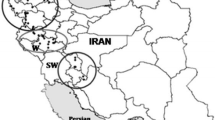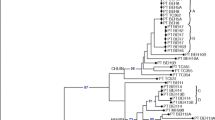Abstract
The genetic diversity of 255 taro (Colocasia esculenta) accessions from Vietnam, Thailand, Malaysia, Indonesia, the Philippines, Papua New Guinea and Vanuatu was studied using AFLPs. Three AFLP primer combinations generated a total of 465 scorable amplification products. The 255 accessions were grouped according to their country of origin, to their ploidy level (diploid or triploid) and to their habitat—cultivated or wild. Gene diversity within these groups and the genetic distance between these groups were computed. Dendrograms were constructed using UPGMA cluster analysis. In each country, the gene diversity within the groups of wild genotypes was the highest compared to the diploid and triploid cultivars groups. The highest gene diversity was observed for the wild group from Thailand (0.19), the lowest for the diploid cultivars group from Thailand (0.007). In Malaysia there was hardly any difference between the gene diversity of the cultivars and wild groups, 0.07 and 0.08, respectively. The genetic distances between the diploid cultivars groups ranges from 0.02 to 0.10, with the distance between the diploid accessions from Thailand and Malaysia being the highest. The genetic distances between the wild groups range from 0.05 to 0.07. First, a dendrogram was constructed with only the diploids cultivars from all countries. The accessions formed clusters largely according to the country from which they originated. Two major groups of clusters were revealed, one group assembling accessions from Asian countries and the other assembling accessions from the Pacific. Surprisingly, the group of diploid cultivars from Thailand clustered among the Pacific countries. Secondly, a dendrogram was constructed with diploid cultivated, triploid cultivated and wild accessions. Again the division of the accessions into an Asian and a Pacific gene pool is obvious. The presence of two gene pools for cultivated diploid taro has major implications for the breeding and conservation of germplasm.


Similar content being viewed by others
References
Hill M, Witsenboer H, Zabeau M, Vos P, Kesseli R, Mitchelmore R (1996) PCR-based fingerprinting using AFLPs as a tool for studying genetic relationships in Lactuca sp. Theor Appl Genet 93:1202–1210
Irwin SV, Kaufusi P, Banks K., de la Pena R, Cho JJ (1998) Molecular characterization of taro (Colocasia esculenta) using RAPD markers. Euphytica 99:183–189
Kardolus JP, Van Eck HJ, Van den Berg RG (1998) The potential of AFLPs in biosystematics: a first application in Solanum taxonomy (Solanaceae). Plant Syst Evol 210:87–103
Kuruvilla KM, Singh A (1981) Karyotypic and electrophoretic studies on taro and its origin. Euphytica 30:405–513
Lebot V (1999) Biomolecular evidence for plant domestication in Sahul. Gen Res Crop Evol 46:619–628
Lebot V, Aradhya M (1991) Isozyme variation in taro [Colocasia esculenta (L.) Schott] from Asia and the Pacific. Euphytica 56:55–66
Matthews PJ (1990) The origins, dispersal and domestication of taro. PhD thesis, Australian National University
Nei M (1978) Estimation of average heterozygosity and genetic distance from small number of individuals. Genetics 89:583–590
Nei M, Li W-H (1979) Mathematical model for studying genetic variation in terms of restriction endonucleases. Proc Nat Acad Sci USA 76:5269–5273
Plucknett DL (1976) Edible aroids: Alocasia, Colocasia, Cyrtosperma, Xanthosoma. In: Simmonds NW (ed) Evolution of crop plants. Longman, London, pp 10–12
Roger SO, Bendich AJ (1988) Extraction of DNA from plant tissues. In: Gelvin SB, Schilperoort RA (eds) Plant molecular biology manual A6. Klewer, Dordrecht, pp 1–10
Rouppe van der Voort JNAM, Van Zandvoort P, Van Eck HJ, Folkertsma RT, Hutten RCB, Draaistra J, Gommers FJ, Jacobsen E, Helder J, Bakker J (1997) Use of allele specificity of comigrating AFLP markers to align genetic maps from different potato genotypes. Mol Gen Genet 255:438–447
Sharma A, Sharma R, Machii H (2000) Assessment of genetic diversity in a Morus germplasm collection using fluorescense-based AFLP markers. Theor Appl Genet 101:1049–1055
Shim SI, Jorgensen RB (2000) Genetic structure in cultivated and wild carrots (Daucus carota L.) revealed by AFLP analysis. Theor Appl Genet 101:227–233
Singh A, Negi MS, Rajagopal J, Bhatia S, Tomar UK, Srivastava PS, Lakshmikumaran M (1999) Assessment of genetic diversity in Azadirachta indica using AFLP markers. Theor Appl Genet 99:272–279
Van Eck HJ, Rouppe Van der Voort J, Draaistra J, van Zandvoort P, Van Enkevort E, Segers B, Peleman J, Jacobsen E, Helder J, Bakker J (1995) The inheritance and chromosomal localization of AFLP markers in a non-inbred potato offspring. Mol Breed 1:397–410
Vos P, Hogers R, Bleeker M, Reians M, Van De Lee T, Hornes M, Frijters A, Pot J, Peleman J, Zabeau M (1995) AFLP: a new technique for DNA fingerprinting. Nucleic Acids Res 23:4407–4414
Acknowledgements
We would like to thank our TANSAO collaborators M. Thongjiem, M.S. Prana, N. Viet, T.C. Yap, R. Pardales and T. Okpul for supplying the material and for the initial screening of the plant material. Further we would like to thank Marjan Bergervoet for her technical assistance with the in vitro collection and Joke van Vliet for her contribution to the AFLP analysis. This study would not have been possible without the support of the INCO programme of the European Commission, Directorate General XII (contract number ERBIC18CT970205).
Author information
Authors and Affiliations
Corresponding author
Additional information
Communicated by G. Wenzel
Rights and permissions
About this article
Cite this article
Kreike, C.M., Van Eck, H.J. & Lebot, V. Genetic diversity of taro, Colocasia esculenta (L.) Schott, in Southeast Asia and the Pacific. Theor Appl Genet 109, 761–768 (2004). https://doi.org/10.1007/s00122-004-1691-z
Received:
Accepted:
Published:
Issue Date:
DOI: https://doi.org/10.1007/s00122-004-1691-z




